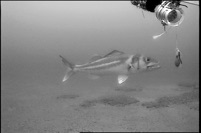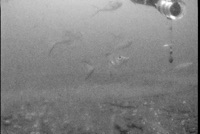BotCam Stationary Stereo-Video Data

DataSet COntact: Dr. Benjamin L. Richards
Description: This dataset contains BotCam stereo-video sequences of Hawaii Bottomfish (Pristipomoides spp., Etelis spp., etc). Video is recorded using a stereo-pair of ROS Navigator low-light cameras at various sites in the Main Hawaiian Islands at depths of 100 - 300m in ambient light. BotCam units also contain a SeaBird SBE39 temperature/depth sensor.
purpose: These video sequences have been used to estimate relative and absolute abundance for use in evaluating Hawaii Bottomfish Restricted Fishing Areas and, in the future, to generate abundance indices for stock assessment.

Example imagery


High Abundance
High Diversity
Low Abundance
Low Diversity
Dark Video
Murky Video
Exemplar videos highlight variance in the following attributes:
-
•Diversity:
-
•Low: single fish (low abundance) or moderate to large grouping of a single species of fish (high abundance). Also, included no fish as low diversity.
-
•111027_084932_A0.mpg (Depth: 155m): 1 Pristipomoides filamentosus – low diversity w/low abundance; gradual panning after touchdown for several minutes then gentle bobbing.
-
•A0090527115230.mpg (Depth: 191m): 21 puffers (Torquigener florealis) – low diversity w/high abundance; most of the drop camera tilts toward sediment substrate (low contrast, homogenous), but prior to tilting a mostly light-colored puffer can be seen against dark horizon (high contrast, possibly heterogeneous since light substrate and dark horizon); initially relatively stationary then camera tilts toward substrate and starts bobbing.
-
•Intermediate: 2-3 identifiable species and/or genera (from 1-2 families)
-
•100526_125014_A0.mpg (Depth: 230m): 1 Pristipomoides filamentosus, 4 Pristipomoides sieboldii, 1 Etelis carbunculus – intermediate diversity and intermediate abundance (lower end of high abundance). Contrast borderline, but chose high as can often distinguish fish outlines, including Pristipomoides sieboldii, in still frames.
-
•110128_142413_A0.mpg (Depth: 163m): 17 Pristipomoides filamentosus & 2 Pristipomoides zonatus. The camera remains relatively stationary for a long period after initial pan, Pristipomoides filamentosus may have caused camera to bob some when hitting the bait canister.
-
•High: 4 or more identifiable species or genera from 3 or more families (up to 21 species, 24 genera, & 16 families.
-
•100927_084637_A0.mpg (Depth: 220m): 1 Etelis carbunculus, 1 Etelis coruscans, 1. Seriola dumerili, 1 B. albotaeniatus. Some boulders, and slightly darker horizon than seafloor, but might be more homogenous. Low contrast video, but outlines of fish are detectable.
-
•120413_102814_A0.mpg (Depth 173m): 30 Pristipomoides (including 4 Pristipomoides filamentosus & 12 Pristipomoides sieboldii), 2 Seriola rivoliana, 8 Naso sp., 1 Mulloidichthys pfluegeri, 4 Aphareus rutilans, 1 butterflyfish (R. excelsa), and 1 thresher shark. Some fish blend into substrate (lower contrast at times); scattered sediment pockets and cavity walls provide darker and lighter areas in a mostly grey background (borderline heterogeneous); slightly grainy, but not murky. Camera movement generally minor.
-
•Abundance
-
•Low: 0 to 5 individuals
-
•A0090321150622.mpg (Depth: 121m): No fish. Seems somewhat grainy, horizon difficult to discern, but plumb weight is clear; contrast probably sufficient to detect fish if present.
-
•120512_113818_A0.mpg (Depth: 298m): No fish. Surprisingly bright for depth; several bioluminescent flashes; several sightings of something elongate drifting by (one identified as salp). Contrast likely sufficient to detect fish. Moderate camera movement due to panning gradually back and forth.
-
•High: 6 or more individuals
-
•090724_103709_A0.mpg (Depth: 140m): suspended algae drifts past camera at times; 2 Carangoides orthogrammus, 13 Pristipomoides filamentosus, 1 Mulloidichthys pfluegeri, 1 Seriola dumerili, 5 Seriola rivoliana, & 1 Epinephelus quernus. Moderate contrast.
-
•Light Intensity
-
•Bright: 121202_143047_A0.mpg (Depth: 167m): 8 Pristipomoides filamentosus, 3 Dasyatis sp., 1 Seriola dumerili, 1 Seriola rivoliana, 1 Aprion virescens, & 1 Epinephelus quernus. Not certain if this counts as an assemblage.
-
•Dark: A0090417154840.mpg (Depth: 246m): No fish.
-
•Water Clarity
-
•Clear: A0090129110952.mpg (Depth: 169m): 7 Pristipomoides filamentosus, 4 Seriola dumerili, 1 Seriola rivoliana. Primarily homogeneous background; moderate camera movement due to gradual panning.
-
•Murky: 090528_132159_A0.mpg (Depth: 246m): 1 Seriola dumerili & 11 Etelis coruscans. Very grainy, but not very dark.
-
•Background
-
•Complexity
-
•Homogeneous: 101230_152547_A0.mpg (Depth: 222m): 1 Seriola rivoliana, 1 Etelis coruscans, 1 Etelis carbunculus. Video grainy; intermediate diversity and intermediate abundance (higher end of low abundance).
-
•Heterogeneous: 130424_124233_A0.mpg (Depth: 127m): 4 Naso sp., 1 Xanthichthys caeruleolineatus, 1 Chaetodon fremblii, 2 C. miliaris, 1 Forcipiger sp., 1 Heniochus diphreutus, 1 Coris ballieui, 2 Aphareus rutilans, 8 Pristipomoides filamentosus, 18 Pristipomoides sieboldii, 60 Chromis (including 25 C. verater), 14 Odontanthias fucipinnis. After landing and initial pan, camera moves little during annotation period; however, lots of movement late in video as camera is retrieved.
-
•Contrast
-
•Low: fish blends into background; difficult to see fish in still image
-
•110305_105413_A0.mpg (Depth: 160m): 1 Carcharhinus plumbeus & 1 Dasyatis sp. Mostly grey background and grey fish (low contrast), but shark seen at times in higher contrast when near lighter portion at the top of the field of view.
-
•High: fish easily seen against background
-
•A0081108125514.mpg (Depth: 191m): 5 Pristipomoides filamentosus, 1 Seriola dumerili, 1 Seriola rivoliana, 1 ray.
-
•Camera Movement
-
•Stationary: after camera lands and settles into position, camera remains relatively still
-
•120926_134739_A0.mpg (Depth: 198m): 13 Seriola dumerili. Minimal movement for most of the drop; some gradual pans
-
•Moving: horizontal (panning or swaying) or vertical (bobbing). Camera movement along seafloor is also identified in separate categories under “Rejected” or “Outliers”.
-
•120413_144949_A0.mpg (Depth: 261m): 4 Etelis coruscans, 4 Etelis carbunculus, 1 Pristipomoides sieboldii, 7 Antigonia sp. Murkiness most likely related to depth rather than marine snow; grainy video; dark, but large amount of light colored sediment brightens image. Pans, bobs, and moves a short distance.
-
•Assemblage Type
-
•Shallow water (<75 m): 101112_091631_A0.mpg (Depth: 109m): Assemblage with high diversity and abundance. 2 Acanthurus dussumieri, 1 Aphareus furca, 3 Aphareus rutilans, 1 Apolemichthys arcuatus, 1 Aulostomus chinensis, 3 Bodianus albotaeniatus, 3 Caranx melampygus, 2 Chaetodon tinkeri, 80 Chromis verater, 2 Forcipiger longirostris, 14 Heniochus diphreutus, 1 Labroides phthirophagus, 25 Lutjanus kasmira, 1 Mullid, 3 Myripristis sp., 4 Naso brevirostris, 14 Naso hexacanthus, 3 Naso maculatus, 5 Odontanthias fuscipinnis, 2 Seriola rivoliana, 2 Sufflamen fraenatum, 40 Symphysanodon typus, & 1 Xanthichthys caeruleolineatus.
-
•Deep water (>225 m): 101211_120144_A0.mpg (Depth: 256m): Assemblage with high diversity. 1 Antigonia sp., 1 Seriola dumerili, 1 Seriola rivoliana, 20 Etelis carbunculus, 50 Etelis coruscans, 16 Pristipomoides sieboldii. Video grainy and some fish sometimes blend into substrate (low contrast)
-
•Rejected videos
-
•Too dark: 110501_153128_A0.mpg (Depth: 258m): 1 Spheroides pachygaster, 1 Etelis carbunculus, & 1 “possible” Etelis coruscans (perciform).
-
•Camera movement
-
•111028_104205_A0.mpg (Depth: 154 to 346m): no information on fish present. Other factors, such as light intensity, not scored as they change considerably during the drop.
-
•130319_092216_A0.mpg (Depth: 165m): 16 Pristipomoides filamentosus, 3 Pristipomoides zonatus, 2 Naso sp., 2 Seriola dumerili, 1 Seriola rivoliana. Camera tilts toward seafloor and is slowly dragged; good views of pencil urchins.
-
•Outliers
-
•Video Pausing: 121023_144840_A0.mpg (Depth: 226m): No fish. Cameras pause some; homogeneous as most of drop was darker open water view with smaller section of light sediment at base of view (since both light and dark areas could consider heterogeneous); contrast probably sufficient to detect fish if present.
-
•Debris in the water: 090725_153738_A0.mpg (Depth: 271m): large amount of algae drifting past lens, both attached and drifting past lens; darkens during drop; 1 Squalus mitsurkii, Aprion virescensrii, and total of 2 fish (probably 2 sharks), couldn’t confirm teleosts. Heterogeneous complexity due to large amount of algae drifting over sediment seafloor.
-
•Tagged Fish: 130425_143907_A0.mpg (Depth: 110m) 3 Naso sp., 12 Pristipomoides filamentosus (one with tag on dorsal surface), 50 Pristipomoides sieboldii, & 1 Aprion virescens. Another dozen fish were present during the annotation period, but couldn’t be identified to order. After landing and initial pan, camera relatively still until snappers start feeding causing camera to bob a little during annotation period. However, lots of movement late in video as camera is retrieved.
how to cite: Richards, B.L., Drazen, J.C., Moriwake, V. (2014) "Hawai'i Deep-7 Bottomfish training and validation image dataset: NOAA Pacific Islands Fisheries Science Center BotCam Stereo-Video."
Measurement Video:
Metadata:




Platform Details
Cameras: ROS Navigator
-
•Analogue
-
•Stereo-Video
-
•Monochrome
-
•Forward-looking
-
•Height above bottom: 5m
-
•Frame Rate: 29.97 fps
-
•Lighting: Ambient
Data Acquisition: 100 hrs per year
Data Archive: 1,500 hrs
Stereo-Video
Details: Two types of video files are provided for algorithm testing. Exemplar videos (provided below) provide examples of the range of video types that may be encountered. Measurement Videos and the associated data tables (below) provide a species, count, size and location for each individual seen in the video.
Individual data sets are password protected to prevent unauthorized download. Please email the chair to request access permissions.

Disclaimer: This web site is provided to disseminate information related to the NOAA Fisheries Strategic Initiative on Automated Image Analysis. This is not an official NOAA website and the views expressed do not necessarily reflect any official position of NOAA, the Department of Commerce, or the government of the United States.
